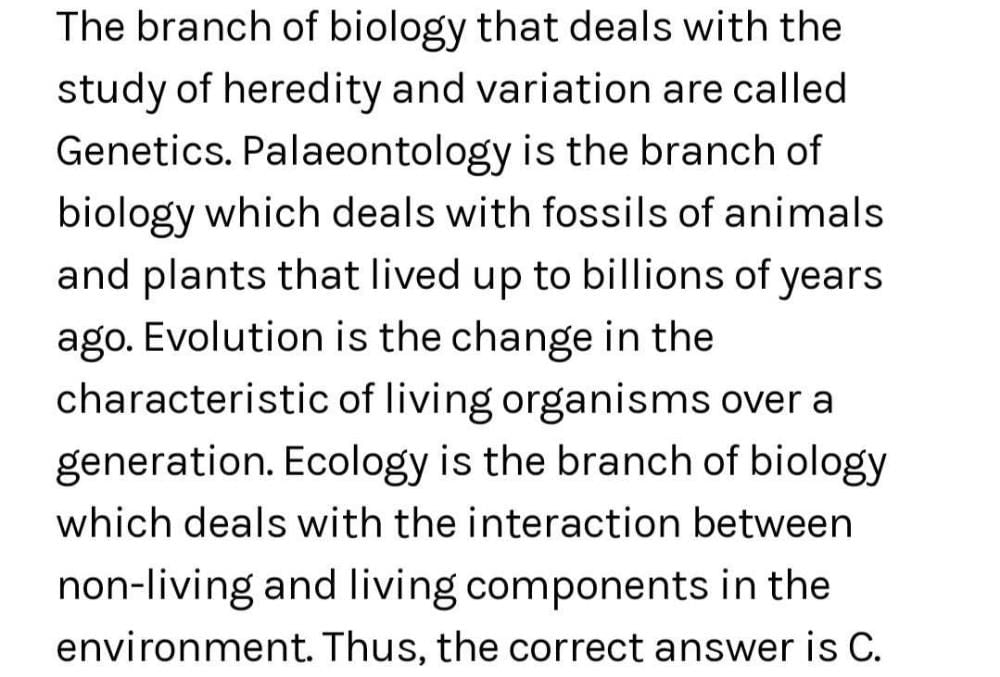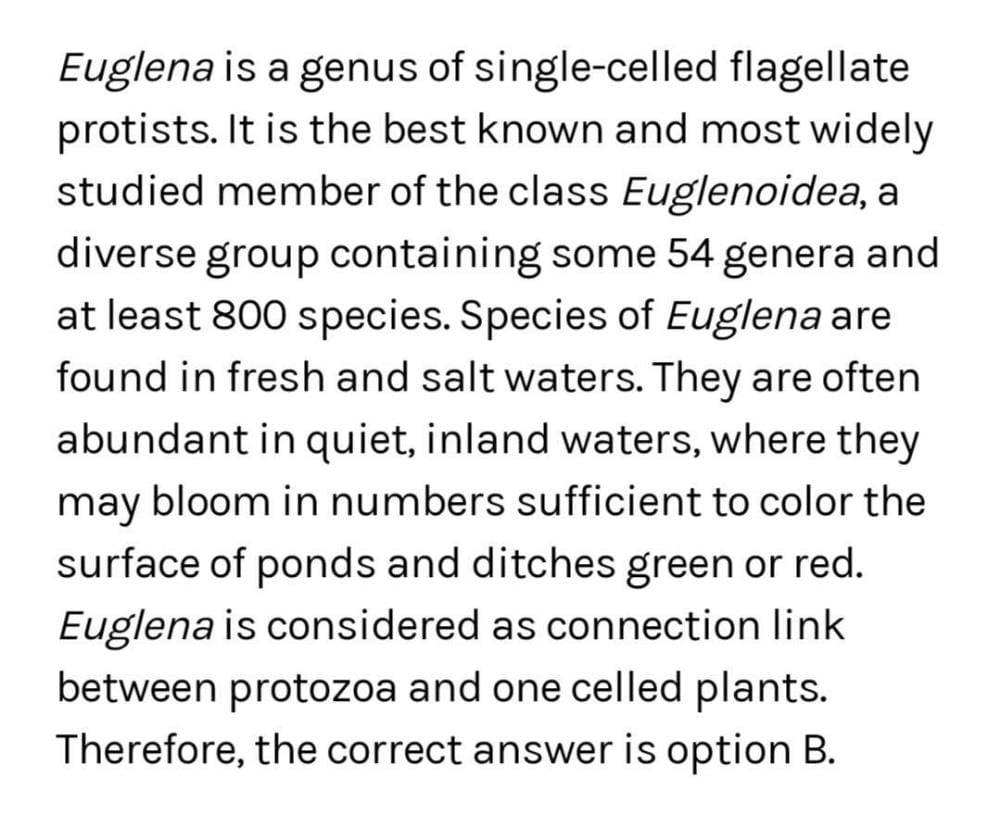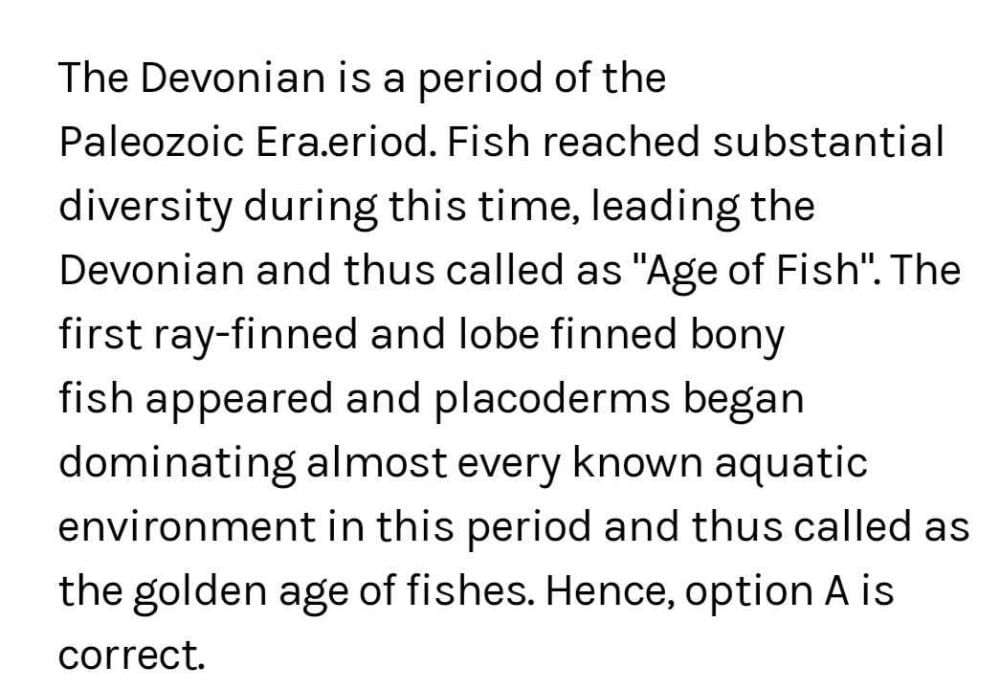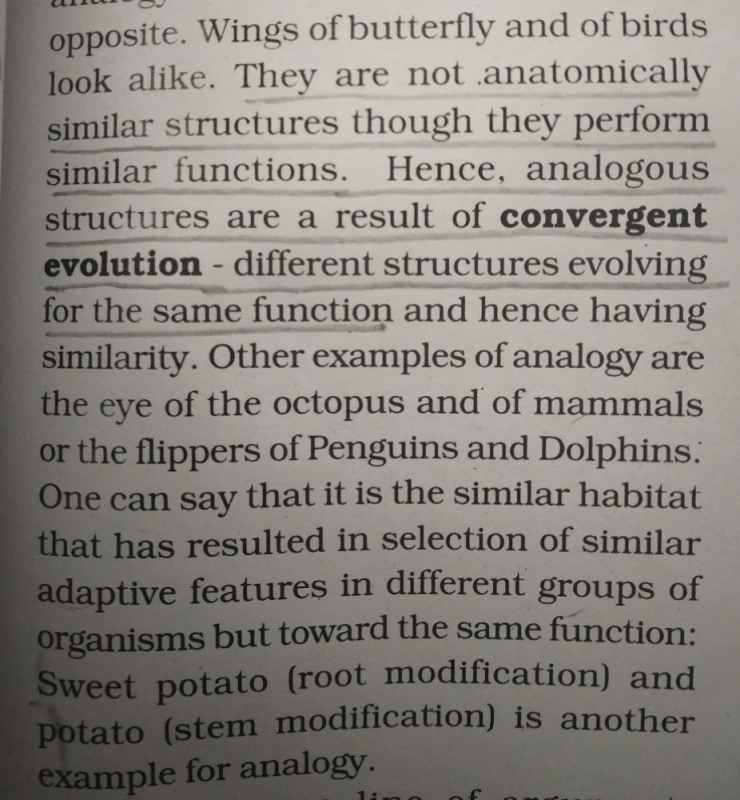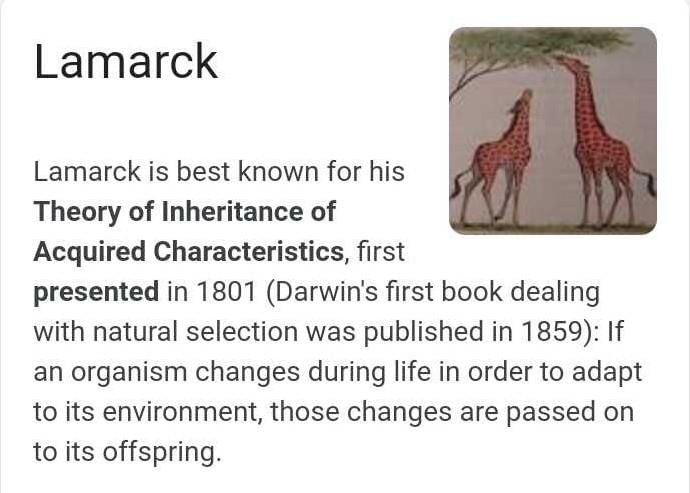All questions of The Origin of Life for Grade 9 Exam
Which of the following orgn in man is not vestigial[CPMT 801]- a)Vermiform appendix
- b)Nictitating membrane
- c)Ear muscles
- d)Epiglottis
Correct answer is option 'D'. Can you explain this answer?
Which of the following orgn in man is not vestigial
[CPMT 801]
a)
Vermiform appendix
b)
Nictitating membrane
c)
Ear muscles
d)
Epiglottis

|
Aditi Priya answered |
Bcoz epiglottis helps in obstructing the entry of bolous into the trachea
Which of the following has homologous organs :[NCERT 78]- a)Hands of man, monkey and kangaroo and trunk of elephant
- b)Wings of insects, birds and bats
- c)Hindi limbs of grasshopper,horse and bat
- d)Mouthparts of cockroach, mosquito and honey bee
Correct answer is option 'D'. Can you explain this answer?
Which of the following has homologous organs :
[NCERT 78]
a)
Hands of man, monkey and kangaroo and trunk of elephant
b)
Wings of insects, birds and bats
c)
Hindi limbs of grasshopper,horse and bat
d)
Mouthparts of cockroach, mosquito and honey bee
|
|
Preeti Iyer answered |
The insects the mouth parts comprise labrum,mandibles and maxilla (representing similar origin and structure) but they have different functions.
Function of mouth in-
Cockroaches - biting and chewing
Honey bee - chewing and lapping
Mosquito - piercing and sucking.
Evidently,the same structure is developed along different divergent evolution and these structures are Homologous.
Function of mouth in-
Cockroaches - biting and chewing
Honey bee - chewing and lapping
Mosquito - piercing and sucking.
Evidently,the same structure is developed along different divergent evolution and these structures are Homologous.
If a particular animal hs shelled eggs, hair and teats of the bodyand has cloaca, it may be a connecting link between- a)Reptiles and birds
- b)Birds and mammals
- c)Reptiles and mammals
- d)None of them
Correct answer is option 'C'. Can you explain this answer?
If a particular animal hs shelled eggs, hair and teats of the bodyand has cloaca, it may be a connecting link between
a)
Reptiles and birds
b)
Birds and mammals
c)
Reptiles and mammals
d)
None of them
|
|
Suresh Iyer answered |
Lycaenops was a mammal-like reptile. It is considered a missing link between reptiles and mammals. Laying shelled eggs is a characteristic of birds and reptiles. Having hair, teats on body and cloaca are characteristics of animals. So, particular animal has shelled eggs, hair and teats on the body and has cloaca, it may be a connecting link between reptiles and mammals. Thus, option C is correct and other options are wrong.
Which bird can not fly:[NCERT 77]- a)Stark
- b)penguins
- c)Duck
- d)Peacock
Correct answer is option 'B'. Can you explain this answer?
Which bird can not fly:
[NCERT 77]
a)
Stark
b)
penguins
c)
Duck
d)
Peacock
|
|
Palak Basu answered |
Penguins are birds that cannot fly, but are excellent swimmers, which is why they spend a lot of time in the water. Out of 18 penguin species, only 3 species live exclusively in Antarctica, while the rest are scattered in many places around the Southern Hemisphere
Life originated in which era : [CPMT 76]
- a)Proterozoic
- b)Mesozoic
- c)Precambrian
- d)Coenozoic
Correct answer is option 'C'. Can you explain this answer?
Life originated in which era : [CPMT 76]
a)
Proterozoic
b)
Mesozoic
c)
Precambrian
d)
Coenozoic

|
Sandy Naaz answered |
The earliest undisputed evidence of life on Earth dates at least from 3.5billion years ago, during the Eoarchean Era, after a geological crust started to solidify following the earlier molten Hadean Eon.
Connecting link between annelida and mollusca : - a)Cuttle fish
- b)Octopus
- c)Neopilina
- d)Nautilus
Correct answer is option 'C'. Can you explain this answer?
Connecting link between annelida and mollusca :
a)
Cuttle fish
b)
Octopus
c)
Neopilina
d)
Nautilus
|
|
Prisha Bajaj answered |
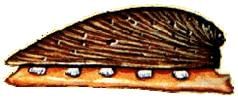
Neopilina is a connecting link between annelids and molluscans. It is the only segmented mollusc. It has a cup shaped shell like that of limpet. Its visceral mass is divided into five segments, each with a pair of shell muscles, gills, auricles, and nephidia.
Dinosaurs are : [BHU 83]- a)Primitive amphinians
- b)Extinct reptiles
- c)Giant mammals
- d) Primitive mammals
Correct answer is option 'B'. Can you explain this answer?
Dinosaurs are :
[BHU 83]
a)
Primitive amphinians
b)
Extinct reptiles
c)
Giant mammals
d)
Primitive mammals
|
|
Kaneez Fatima answered |
Dinosaurs went extinct about 65 million years ago (at the end of the Cretaceous Period), after living on Earth for about 165 million years.
Which of the following organs in man is vestigial : [CPMT 77]- a)Pinna
- b)Wisdom tooth
- c)Fossa ovalis
- d)Ileum
Correct answer is option 'B'. Can you explain this answer?
Which of the following organs in man is vestigial : [CPMT 77]
a)
Pinna
b)
Wisdom tooth
c)
Fossa ovalis
d)
Ileum

|
Surya answered |
Vestigial organs means evidence for the evolution.. so as per the given option...wisdom teeth is the vestigial organ...so the option B is correct...
Dinosaurs originated : [CPMT 86]- a)After evolution of mammals
- b)With mammals
- c)Much before mammals
- d)Before mammals and they formed them
Correct answer is option 'B'. Can you explain this answer?
Dinosaurs originated : [CPMT 86]
a)
After evolution of mammals
b)
With mammals
c)
Much before mammals
d)
Before mammals and they formed them
|
|
Siddiq Zayeda answered |
Mammals appeared on the earth long before the extinction of the dinosaurs; in fact, dinosaurs and mammals originated within 10 million years of each other, in the late Triassic about 200 million years ago.........
Homologous organs have :[MP PMT 01]- a)Similar origin and similar or dissimilar functions
- b)Dissimilar origin and structure
- c)Dissimilar origin and function
- d)Dissimilar origin and similar functions
Correct answer is option 'A'. Can you explain this answer?
Homologous organs have :
[MP PMT 01]
a)
Similar origin and similar or dissimilar functions
b)
Dissimilar origin and structure
c)
Dissimilar origin and function
d)
Dissimilar origin and similar functions
|
|
Afifa Aaliya answered |
Organs such as bats of wings, wings of birds, seals of flippers, arms of humans have common underlying anatomy. That was present in last common Ancestors. forelimbs are homologous organs. homology refers to the traits inherited by two different organisms from common ancestry. so it has similar origin and different or similar functions.
So option " A " is correct answer.
So option " A " is correct answer.
There are no life in which era :[CPMT 80]- a)Messozoic era
- b)Palaeozoic era
- c)Coenozoic era
- d)Azoic era
Correct answer is option 'D'. Can you explain this answer?
There are no life in which era :
[CPMT 80]
a)
Messozoic era
b)
Palaeozoic era
c)
Coenozoic era
d)
Azoic era
|
|
Ayeshashreya Mishra answered |
During Azoic era, the earth was with out plants and animals. The rock layers which were formed soon after azoic era contains the remains of limy sea plants.The word "Azoic" is derived from the Greek, a- meaning without and zoon meaning animal (or living being), it was first used to mean without life.....
An era ''age of birds and mammals'' is : [CPMT 93]- a)Mesozoic
- b)Palaecozoic
- c)Coenozoic
- d)Cretaceous
Correct answer is option 'C'. Can you explain this answer?
An era ''age of birds and mammals'' is : [CPMT 93]
a)
Mesozoic
b)
Palaecozoic
c)
Coenozoic
d)
Cretaceous
|
|
Afifa Aaliya answered |
The Cenozoic era is the most recent of the three major sub division of the animal history. The other two are the Mesozoic and Peliozoic eras. The Cenozoic era only about 65 million years. From the end of the Cretaceous period and the extension of non avian dinosaurs to the present. The Cenozoic is sometimes called as age of mammals because the largest land animals have been mammals during that time.
So option " C " is correct answer.
So option " C " is correct answer.
Evolution of birds and mammals occurred in : [CPMT 83]- a)Eocene and oligocene periods
- b)Silurian and Devonian periods
- c)Carboniferous and Permain epochs
- d)Jurasic period
Correct answer is option 'D'. Can you explain this answer?
Evolution of birds and mammals occurred in :
[CPMT 83]
a)
Eocene and oligocene periods
b)
Silurian and Devonian periods
c)
Carboniferous and Permain epochs
d)
Jurasic period
|
|
Baishali Joshi answered |
The evolution of birds and mammals occurred in Jurassic period. The earliest birds were derived from a clade of theropod dinosaurs named paraves. Mammals evolved 10 times faster in the middle of the Jurassic period.
If a starfish possess 6 arms instead of 5, it is an example of :[CPMT 84]- a)Variation
- b)Metamorphosis
- c)Biogenesis
- d)Evolution
Correct answer is option 'A'. Can you explain this answer?
If a starfish possess 6 arms instead of 5, it is an example of :
[CPMT 84]
a)
Variation
b)
Metamorphosis
c)
Biogenesis
d)
Evolution
|
|
Afifa Aaliya answered |
If a starfish possess 6 arms instead of 5 it's an example of variations. Because it is in difference between cells individual organisms of any species caused either genetic difference. Variations may show physical appearance, metabolism, fertility.., etc..,
So option " A " is correct answer.
So option " A " is correct answer.
The mesozoic era of earth is called the : [CPMT 84]- a)Age of amphibians
- b)Age of armoured fishes
- c)Age of primitive man
- d)Age of ruling reptiles
Correct answer is option 'D'. Can you explain this answer?
The mesozoic era of earth is called the : [CPMT 84]
a)
Age of amphibians
b)
Age of armoured fishes
c)
Age of primitive man
d)
Age of ruling reptiles
|
|
Yamuna Mani answered |
Mesozoic era or middle life era is the life diversified rapidly and giant reptiles,dinosaurs and other monstrous beads roamed the earth. so it is called as age of reptiles era.
Galapagos islands are connected with which scientist : [BHU 80]- a)Wallace
- b)Lamarck
- c)Malthus
- d)Darwin
Correct answer is option 'D'. Can you explain this answer?
Galapagos islands are connected with which scientist :
[BHU 80]
a)
Wallace
b)
Lamarck
c)
Malthus
d)
Darwin
|
|
Nayanika Patel answered |
The name of Charles Darwin and his famous book The Origin of Species will forever be linked with the Galapagos Islands. Although he was only in the Galapagos for five weeks in 1835, it was the wildlife that he saw there that inspired him to develop his Theory of Evolution.
Wings of locust, pigeon, and bat are example of :[CPMT 84]- a)Vestigial organs
- b)Analogous organs
- c)Homologous organs
- d)Evolution
Correct answer is option 'B'. Can you explain this answer?
Wings of locust, pigeon, and bat are example of :
[CPMT 84]
a)
Vestigial organs
b)
Analogous organs
c)
Homologous organs
d)
Evolution
|
|
Jyoti Sengupta answered |
The organs which have different embryonic origin but perform same function are called as analogous organs, e.g., wings of bat and insects. The organs which have same embryonic origin but adapted to perform different functions are known as homologous organs, e.g., wing of bat and forelimb of humans.
Who was the first to explain recapitulatin theory :[CPMT 78, 80]- a)Weismann
- b)Muller and Haeckel
- c)Darwin
- d)Malthus
Correct answer is option 'B'. Can you explain this answer?
Who was the first to explain recapitulatin theory :
[CPMT 78, 80]
a)
Weismann
b)
Muller and Haeckel
c)
Darwin
d)
Malthus

|
Sandy Naaz answered |
The theory of recapitulation, also called the biogenetic law or embryological parallelism—often expressed using Ernst Haeckel's phrase "ontogeny recapitulates phylogeny"—is a historical hypothesis that the development of the embryo of an animal, from fertilization to gestation or hatching (ontogeny), goes through ...
Which of the following sets do not have homologous organs : - a)Wings of mosquito and butterfly
- b)All of them
- c)Mouth parts of cockroach and butter fly
- d)Wings of butterfly and bird
Correct answer is option 'D'. Can you explain this answer?
Which of the following sets do not have homologous organs :
a)
Wings of mosquito and butterfly
b)
All of them
c)
Mouth parts of cockroach and butter fly
d)
Wings of butterfly and bird

|
Gundappa Karamadi answered |
Origin is different and function same
Earliest fossil form in the phylogeny of horse is : [CBSE 94]- a)Mesohippus
- b)Equus
- c)Eohippus
- d)Merychippus
Correct answer is option 'C'. Can you explain this answer?
Earliest fossil form in the phylogeny of horse is : [CBSE 94]
a)
Mesohippus
b)
Equus
c)
Eohippus
d)
Merychippus
|
|
Tejas Chakraborty answered |
Hoofed animals like-horse orginated in Eocene epoch in North America. First horse-like animals from which the modern horse Equus evolved was Hyracotherium (old name Eohippus). The fossil record is most complete in horse.
Fossils are dated by : [CPMT 74, AFMC 80]- a)Amount of calcium residue
- b)Amount of radioactive carbon compound
- c)Association with other mammlas
- d)Structure of bones
Correct answer is option 'B'. Can you explain this answer?
Fossils are dated by :
[CPMT 74, AFMC 80]
a)
Amount of calcium residue
b)
Amount of radioactive carbon compound
c)
Association with other mammlas
d)
Structure of bones
|
|
Shivani Dasgupta answered |
Fossils are dated using various methods, and one such method is the use of radioactive carbon compounds. This method, known as radiocarbon dating or carbon-14 dating, allows scientists to determine the age of organic remains by measuring the amount of radioactive carbon-14 present in the sample.
Radiocarbon dating is based on the fact that carbon-14 is a radioactive isotope of carbon that is constantly formed in the atmosphere by cosmic rays. This carbon-14 is then absorbed by living organisms, such as plants and animals, through the process of photosynthesis or consumption. When these organisms die, the carbon-14 in their bodies begins to decay at a predictable rate.
The decay of carbon-14 is measured by its half-life, which is the time it takes for half of the carbon-14 atoms to decay into nitrogen-14. The half-life of carbon-14 is approximately 5730 years. By measuring the ratio of carbon-14 to carbon-12 in a fossil, scientists can determine how long it has been since the organism died.
To determine the age of a fossil using radiocarbon dating, scientists extract a small sample of organic material, such as bone or wood, from the fossil. They then measure the amount of carbon-14 in the sample using a technique called accelerator mass spectrometry. This method allows for incredibly precise measurements of carbon-14 levels, even for samples that are thousands of years old.
By comparing the amount of carbon-14 in the sample to the known levels of carbon-14 in the atmosphere at the time the organism died, scientists can calculate the age of the fossil. This method is particularly useful for dating fossils that are less than 50,000 years old.
In conclusion, fossils are dated using radiocarbon dating, which involves measuring the amount of radioactive carbon-14 in the sample. This method allows scientists to determine the age of organic remains by comparing the carbon-14 levels to known atmospheric levels. Radiocarbon dating is a valuable tool in paleontology and archaeology, providing insights into the age and history of ancient organisms.
Radiocarbon dating is based on the fact that carbon-14 is a radioactive isotope of carbon that is constantly formed in the atmosphere by cosmic rays. This carbon-14 is then absorbed by living organisms, such as plants and animals, through the process of photosynthesis or consumption. When these organisms die, the carbon-14 in their bodies begins to decay at a predictable rate.
The decay of carbon-14 is measured by its half-life, which is the time it takes for half of the carbon-14 atoms to decay into nitrogen-14. The half-life of carbon-14 is approximately 5730 years. By measuring the ratio of carbon-14 to carbon-12 in a fossil, scientists can determine how long it has been since the organism died.
To determine the age of a fossil using radiocarbon dating, scientists extract a small sample of organic material, such as bone or wood, from the fossil. They then measure the amount of carbon-14 in the sample using a technique called accelerator mass spectrometry. This method allows for incredibly precise measurements of carbon-14 levels, even for samples that are thousands of years old.
By comparing the amount of carbon-14 in the sample to the known levels of carbon-14 in the atmosphere at the time the organism died, scientists can calculate the age of the fossil. This method is particularly useful for dating fossils that are less than 50,000 years old.
In conclusion, fossils are dated using radiocarbon dating, which involves measuring the amount of radioactive carbon-14 in the sample. This method allows scientists to determine the age of organic remains by comparing the carbon-14 levels to known atmospheric levels. Radiocarbon dating is a valuable tool in paleontology and archaeology, providing insights into the age and history of ancient organisms.
Fossil X can be considered to have evolved earlier than fossil Y if : [CPMT 93]- a)Y has vestigial structures that are homologous to functional structures in fossil X
- b)Y is structurally more complex than fossil X
- c)Y is in better state of preservation than X
- d)X is found in lower stratum of undisturbed sedimentary rock than Y
Correct answer is option 'A'. Can you explain this answer?
Fossil X can be considered to have evolved earlier than fossil Y if : [CPMT 93]
a)
Y has vestigial structures that are homologous to functional structures in fossil X
b)
Y is structurally more complex than fossil X
c)
Y is in better state of preservation than X
d)
X is found in lower stratum of undisturbed sedimentary rock than Y
|
|
Pooja Mehta answered |
Fossil 'X' can be considered to have evolved earlier than fossil 'Y' if fossil 'X' is found in lower stratum of undisturbed sedimentary rock than 'Y'. Fossils are preserved forms of living organisms that really existed on earth. Presence of 'X' in lower stratum indicates that it existed of 'X' in lower stratum indicates that it existed much before than 'Y'.
Prototheria have developd from [BHU 80, CPMT 77]- a)Birds
- b)Eutheria
- c)Amphibia
- d)Reptilia
Correct answer is option 'D'. Can you explain this answer?
Prototheria have developd from [BHU 80, CPMT 77]
a)
Birds
b)
Eutheria
c)
Amphibia
d)
Reptilia
|
|
Naina Bansal answered |
Prototherians appears to be a combination of reptiles,birds and true mammals. The ancestors of this group are Eutherians and Metatherian. Prototherians split from their ancestors before these become the placental mammals and hence, formed a separate group. They adapted to harsher and diverse groups.
Change with desent is the basis of which theory :- a)Recapitulation theory
- b)Oparin's theory
- c)Theory of organic evolution
- d)Cell theory
Correct answer is option 'C'. Can you explain this answer?
Change with desent is the basis of which theory :
a)
Recapitulation theory
b)
Oparin's theory
c)
Theory of organic evolution
d)
Cell theory
|
|
Raza Great answered |
The evolutionary term descent with modification is most often associated with human evolution, but it is actually a more general term than that would suggest. Simply put, descent with modification means that traits are passed down from generation to generation and sometimes undergo changes or modifications over time. These changes may be caused by natural selection or even a mutation of DNA. It is a theory of organic evolution.
What is the Age of man : - a)Proterozoic
- b)Recent
- c) Mesozoic
- d)100 years
Correct answer is option 'B'. Can you explain this answer?
What is the Age of man :
a)
Proterozoic
b)
Recent
c)
Mesozoic
d)
100 years

|
Sara Khan answered |
B option-- RECENT
man originated in coenozoic era, which is presently the lastest era, among these, Recent is the correct answer
man originated in coenozoic era, which is presently the lastest era, among these, Recent is the correct answer
Which food habit of Darwin’s finches lead to the development of many other varieties?- a)Fruiteater
- b)Cactus eater
- c)Insect eater
- d)Seedeater
Correct answer is option 'D'. Can you explain this answer?
Which food habit of Darwin’s finches lead to the development of many other varieties?
a)
Fruiteater
b)
Cactus eater
c)
Insect eater
d)
Seedeater

|
Lead Academy answered |
- It was from the seed-eating finches, many other altered forms of beak arose enabling them to be insect, cactus or fruit eaters.
- This led to the discovery of Adaptive radiation.
- Darwin’s finches are one of the best examples of this process.
Golden age of Dinosaurs was during: [NCERT 761]- a)Coenozoic era
- b)Palaeozoic era
- c)Archeozoic era
- d)Mesozoic era
Correct answer is option 'D'. Can you explain this answer?
Golden age of Dinosaurs was during:
[NCERT 761]
a)
Coenozoic era
b)
Palaeozoic era
c)
Archeozoic era
d)
Mesozoic era
|
|
Raza Great answered |
The Mesozoic Era is literally the era of middle life. It is also known as the age of dinosaurs. It lasted from 245 to 65 million years ago and is divided into the three periods. The Mesozoic began with the supercontinent Pangaea. Then, during the era, Pangaea broke up and the continents drifted apart. The movement of continents changed climates. It also caused tremendous volcanic activity. Mass extinctions occurred at the end of the Triassic and Cretaceous Periods. The first extinction paved the way for a dinosaur takeover. In the second extinction, the dinosaurs finally disappeared
Archaeopteryx is connecting link because : [BHU 82]- a)It possessed characters of reptiles and aves
- b)It had characters of reptiles and mammals
- c)It was a reptile not a bird
- d)It had characters of non chordates and chordates
Correct answer is option 'A'. Can you explain this answer?
Archaeopteryx is connecting link because :
[BHU 82]
a)
It possessed characters of reptiles and aves
b)
It had characters of reptiles and mammals
c)
It was a reptile not a bird
d)
It had characters of non chordates and chordates
|
|
Ananya Singh answered |
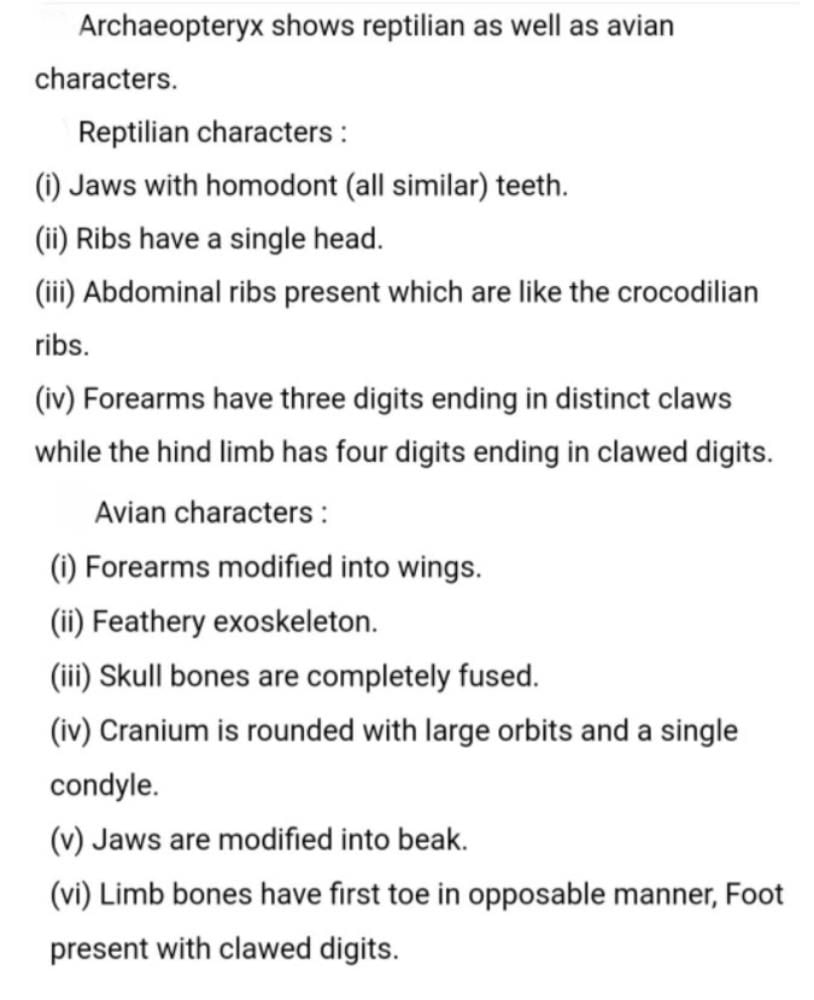
Fossilization can occur where[CPMT 91]- a)Animals are buried and preserved by natural process
- b)Animals are destroyed by scavangers
- c)Animals are eaten by predatos
- d)Animals are destroyed by environmental conditions
Correct answer is option 'A'. Can you explain this answer?
Fossilization can occur where
[CPMT 91]
a)
Animals are buried and preserved by natural process
b)
Animals are destroyed by scavangers
c)
Animals are eaten by predatos
d)
Animals are destroyed by environmental conditions
|
|
Pooja Mehta answered |
Fossilization occurs after an organism dies and only affects hard body parts, such as bones and shells. Soft flesh, scales, and feathers will not become fossils, although, imprints of these parts are sometimes made. In order for fossilization n to occur three things must happen. First, an organism dies.
_______ was the island where Darwin visited and discovered adaptive radiation?- a)Archipelago
- b)Lakshadweep
- c)Port Blair
- d)Galapagos
Correct answer is option 'D'. Can you explain this answer?
_______ was the island where Darwin visited and discovered adaptive radiation?
a)
Archipelago
b)
Lakshadweep
c)
Port Blair
d)
Galapagos

|
Lead Academy answered |
- During the voyage of Darwin, he visited the Galapagos island.
- There, he came across different varieties of species. He saw the variations in the modification of beaks of finches.
Which of the following set in men include vestigial organs :[CPMT 81- a)Coccyx, vermiform appendix and ear muscles
- b)Body hair, atlas vertebra and ear muscles
- c)Coccyx, wisdom tooth and patella
- d)Body hair, cochlea, vermiform appendix and tongue
Correct answer is option 'A'. Can you explain this answer?
Which of the following set in men include vestigial organs :
[CPMT 81
a)
Coccyx, vermiform appendix and ear muscles
b)
Body hair, atlas vertebra and ear muscles
c)
Coccyx, wisdom tooth and patella
d)
Body hair, cochlea, vermiform appendix and tongue
|
|
Anjana Chakraborty answered |
Vestigial organs are those organs which are non-functional in the possessor but were functional in their ancestors and in related animals. Human beings possess many vestigial organs like nictitating membrane in the eye, vermiform appendix at the end if caecum, coccyx and tail muscles, non-functional muscles of the pinna, wisdom teeth, segmental muscle of abdomen and nipples in males.
Which is vestigial organ in man : [AFMC 79]- a)Pinna
- b)Pinna muscles
- c)IIeum
- d)Teeth
Correct answer is option 'B'. Can you explain this answer?
Which is vestigial organ in man :
[AFMC 79]
a)
Pinna
b)
Pinna muscles
c)
IIeum
d)
Teeth
|
|
Jatin Shah answered |
There are about 100 vestigial organs in human being like rudimentry ear muscles (much developed in have elephant and cow) third molar, coccyx (4-5 coccygeal vertebrae) scalp muscle, vermiform appendix, nictitating membrane, ear pinna muscle is vestigial but ear functional bone in man, olecranon process is related to nervous system.
Chapter doubts & questions for The Origin of Life - Biology 2025 is part of Grade 9 exam preparation. The chapters have been prepared according to the Grade 9 exam syllabus. The Chapter doubts & questions, notes, tests & MCQs are made for Grade 9 2025 Exam. Find important definitions, questions, notes, meanings, examples, exercises, MCQs and online tests here.
Chapter doubts & questions of The Origin of Life - Biology in English & Hindi are available as part of Grade 9 exam.
Download more important topics, notes, lectures and mock test series for Grade 9 Exam by signing up for free.
Biology
153 videos|283 docs|127 tests
|

Contact Support
Our team is online on weekdays between 10 AM - 7 PM
Typical reply within 3 hours
|
Free Exam Preparation
at your Fingertips!
Access Free Study Material - Test Series, Structured Courses, Free Videos & Study Notes and Prepare for Your Exam With Ease

 Join the 10M+ students on EduRev
Join the 10M+ students on EduRev
|

|
Create your account for free
OR
Forgot Password
OR
Signup on EduRev and stay on top of your study goals
10M+ students crushing their study goals daily

